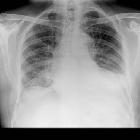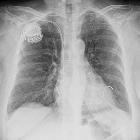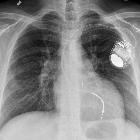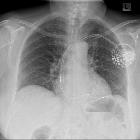Cardiac conduction devices


























Implantable cardiac conduction devices (also known as cardiac implantable electronic devices or CIEDs) are a very common medical device of the thorax, with over one million implanted in the United States of America alone.
There are two major types of cardiac conduction devices: pacemakers and automatic implantable cardioverter-defibrillators (AICD/ICD), and these may be co-implanted as an ICD-pacemaker combination. Both have two major components:
Pacemakers
Cardiac pacemakers may be temporary or permanent, with the latter commonly known by the acronym PPM (permanent pacemaker).
Categorization depends on the number of electrodes and location of pacing:
- single chamber cardiac pacers: lead terminates in the right ventricle
- dual chamber cardiac pacers: leads terminate in the right atrial appendage and right ventricular apex
- biventricular pacers: also known as cardiac resynchronisation therapy, a normal dual chamber system with an additional lead that is introduced along the coronary sinus and wedged in a left ventricular cardiac vein overlying the left ventricle
- epicardial biventricular pacers: epicardial wires are usually placed during cardiac surgery and tend to be placed over the left ventricular apex, right atrial appendage, and right ventricular apex
- leadless cardiac pacers: implanted into the right ventricle with no leads, introduced in 2015 (should not be mistaken for loop recorders)
Automatic implantable cardioverter defibrillators
AICDs are common cardiac devices designed for both patient monitoring and therapy in case of ventricular tachycardia or fibrillation. AICDs consist of various combinations of sensing and shocking electrodes. They are frequently combined with a pacemaker as a bundled system for the patient, treating both the patient’s established arrhythmia and also acting as a fail-safe system should ventricular fibrillation or ventricular tachycardia occur.
Some types of AICD have leads that are implanted in the subcutaneous soft tissues (i.e. outside the thoracic cavity) .
Siehe auch:
- passagerer Herzschrittmacher
- intrakardialer Herzschrittmacher
- AAI Schrittmacher
- Herzschrittmacher MRT Sicherheit
- Dreikammerschrittmacher (biventrikulärer Herzschrittmacher)
- DDD Schrittmacher
- VVI-Herzschrittmacher
und weiter:

 Assoziationen und Differentialdiagnosen zu Permanent pacemakers (PPM):
Assoziationen und Differentialdiagnosen zu Permanent pacemakers (PPM):

